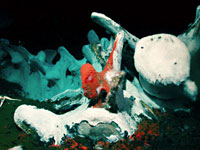WALNUT CREEK, CA–Groundbreaking research led by the U.S. Department of Energy Joint Genome Institute (DOE JGI) demonstrates for the first time that the signatures of the genes alone in terrestrial and aquatic samples can accurately diagnose the health of the sampled environments. This study, published in the April 22nd edition of the journal Science, positions large-scale genome sequencing to accelerate advances in environmental sciences akin to the contributions DNA sequencing has made to biomedical sciences.

Whale fall in the Santa Cruz Basin. Photo taken about one mile below sea level 4.5 years after the whale was sunk in 1998. Photo: Craig Smith, University of Hawaii.
“These DNA sequence fingerprints can be used to provide highly accurate assessments of the vitality of extremely diverse environments,” said Dr. Raymond L. Orbach, Director of the DOE Office of Science, which supported the research. “These fingerprints can be used to reveal environments under stress as well as signal progress in remediating contaminated environments. This may well develop environmental ecology into a fully quantitative science.”
Dubbed Environmental Genomic Tags, or EGTs, these indicators capture a DNA profile of a particular niche and reflect the presence and levels of nutrients, pollutants, and other environmental features.
The EGT approach employed in the study shares similarities with aspects of the Human Genome Project research. In the early 1990s, incomplete fragments of human genes called Expressed Sequence Tags (ESTs) were used as diagnostic fingerprints for human tissues to determine their unique features and disease status. These information-rich data allowed researchers to forge ahead with studying genes important in disease processes, long before the completion of the entire human genome.
“EGT fingerprints may be able to offer fundamental insights into the factors impacting on various environments,” said DOE JGI Director, Eddy Rubin, who led the research team. “With EGTs we don’t actually need a complete genome’s worth of data to understand the functions required of the organisms living in a particular setting. Rather, the genes present and their abundances in the EGT data reflect the demands of the setting and, accordingly, can tell us about what’s happening in an environment without knowing the identities of the microbes living there.”
The EGT fingerprints capture a DNA profile of a particular niche and reflect the presence and levels of nutrients, and pollutants, as well as features like the light and temperature. For example, genes involved in breaking down plant material are overrepresented in soil and absent in the sea water, while in sea water, genes involved in the passage of sodium, a major chemical component of salt water, are particularly abundant. As light is a major energy source for microbes living in surface water, there was an abundance of genes involved in photosynthesis in samples collected from shallow water. These differences in the abundances of genes involved in particular functions provide DNA clues to features of the environments from where the samples were taken. Importantly, the DNA clues were easy to find despite the vast numbers of different individual microbial species within the samples.
Rubin argues that the genes and their relative abundance as gleaned from EGTs reflect the intricate physical and biochemical details of a given environment without having to know the actual identities of the resident microbes. This finding is crucial for studies of microbes in the wild since the sheer number of different organisms present in nearly all environments makes it a daunting task to sequence the multitude of organisms one at a time. With the EGT approach, an abbreviated sequencing effort enables scientists to piece together the information and form a useful metabolic picture of an entire complex environment.
This study was done in collaboration with Diversa Corporation of San Diego, Calif., who provided the DNA from the different environments which included soil from a Minnesota farm and samples of several different whale skeletons collected from the Pacific and Artic ocean depths separated by thousands of miles. The DNA was then sequenced and analyzed by the JGI. While different environments present different metabolic pictures, this research, Rubin said, facilitates a holistic perspective on environmental systems, something that many scientists will welcome.
“Environmental systems are extremely complex, harboring numerous diverse species coexisting in a single locale,” said Rubin. “By focusing on the information encoded in the DNA fragments sequenced, independent of the organisms from which they derived, we were able to get around the problem of species diversity.”
Very little is known about the microbes, since the vast majority of them, some 99 percent, are resistant to being grown under standard laboratory conditions. The EGT strategy’s particular utility is that it offers an easily accessible window into that important part of the biosphere with significant impact on the environment.
DOE JGI postdoctoral fellow Susannah Green Tringe was first author on the Science paper that, in addition to other DOE JGI scientists, included collaborators from Diversa Corporation, and the European Molecular Biology Laboratory, Heidelberg, Germany.
The DOE Joint Genome Institute, supported primarily by the Department of Energy’s Office of Biological and Environmental Research in the DOE Office of Science, is among the world leaders in whole-genome sequencing projects devoted to microbes and microbial communities, model system vertebrates, aquatic organisms, and plants. Established in 1997, JGI now unites the expertise of four national laboratories, Lawrence Berkeley, Lawrence Livermore, Los Alamos, and Oak Ridge, along with the Stanford Human Genome Center to advance the frontiers of genome sequencing and related biology. Additional information about JGI can be found at http://www.jgi.doe.gov/.